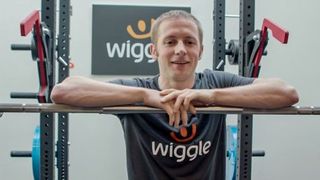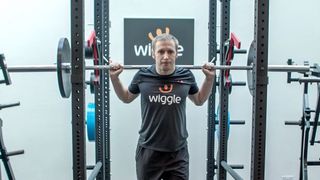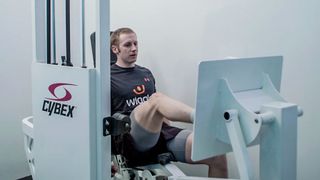Prime Your Legs For Success With Jason Kenny’s Gold Medal Workout
Whether you want extra speed on your bike or just massive legs, this workout will help

You know who never skips leg day? Jason Kenny. The man has thighs like tree trunks and those trees are definitely sequoias, not slender birches. Kenny needs that size and strength to propel himself around a velodrome at the absurd speeds that have helped him capture six Olympic gold medals – along with Chris Hoy (another man with terrifyingly large legs), that’s the most won by any British athlete.
Kenny is aiming to pull clear of Hoy at the Tokyo Olympics in 2020 having recently reversed his decision to retire from track cycling. We spoke to Kenny about that decision at the launch of Wiggle’s new gym gear section, and, in the interests of showing Coach readers how time in the gym can benefit performance in the activity they’re passionate about, Kenny walked us through a typical session. Which was somewhat ironic, considering we found walking trickier than normal afterwards.
Did you find it tough to stop cycling after the Rio Olympics?
It was easy! I’d been so focused and I’d totally had enough. It wasn’t that I didn’t enjoy it – I did – but it was really restrictive and I just wanted to be normal for a bit.
I was dead serious in my head that Rio was my last race. I never intended to race g again. Afterwards, I still exercised and I went out on my bike loads. I just did it when I felt like it – that was the difference. When I had to go in the gym I didn’t really enjoy it that much – but I missed the feeling and I like training in the gym now.
It was good to have that refresh. That’s why I came back, because I realised I did actually enjoy training.
How hard has it been to pick up the workload again?
It’s difficult – you don’t realise how hard you trained when you were full-time until you take a break and try starting again. And obviously a new baby is another challenge thrown into the mix.
It’s something we’re learning about [Kenny is married to Laura Kenny née Trott, Britain’s most successful female Olympian with four golds thus far – an impressive household]. It’s about training when you can and accepting your limitations.
Get the Coach Newsletter
Sign up for workout ideas, training advice, reviews of the latest gear and more.
If you’ve not slept all night and you’ve not recovered properly, you’re going struggle potentially to hit the numbers you want to hit. You just have to accept that and maybe take a bit of volume out of your programme and be a bit more flexible.
It’s a new challenge for me, because I’m used to planning every single day and going into really fine detail. When you throw a seven-week-old into that…
Hopefully it will work. I didn’t think it would be possible, but having talked to people who have done it, it’s about learning to adapt and as athletes you’re always adapting.
How often do you train in the gym?
Between two and three times a week in general training. It comes down a bit in the lead-up to a competition. The key point is that it’s there to support the track cycling. Once it gets to the stage where you’re not going to get the benefit until after the competition, I always think what’s the point?
Do other cyclists enjoy gym training more?
I think some people do love the gym – it’s really easy to see progress because the weight is going up as you get stronger. Whereas on the bike you can work hard, but other factors might stop you going faster.
Is it all leg work?
Yeah, it’s all about the legs. It sounds obvious but you have to keep reminding yourself that everything you do is to support the track, because you find yourself getting carried away sometimes. In the past I’ve been guilty of chasing weights.
In the gym we try to raise our bar for pure strength output, which we can hopefully transfer to power on the track. It’s also good for injury prevention and general conditioning. What we do on the track is quite specific and very repetitive. A lot of injuries we get in cycling are overuse injuries. There’s no impact – other than when you crash!
Jason Kenny’s Workout
Kenny guided us through a typical workout, which is broken down into three sections and takes around 90 minutes to complete. The first section is mobility drills to warm up the back in particular – think downward-facing dog. Then he does two key lifts – squats and leg presses – before doing a 20-minute circuit of deadifts, planks and hanging leg raises for general conditioning.
Barbell squats

Kenny starts with higher amounts of reps (around eight to ten) in the 60-90kg weight range to warm up, before building up to heavier weights with lower reps.
“I might do six reps on 110kg, four reps on 130 and then a double on 140,” says Kenny. “From there it depends – if I'm doing high volume, then I won’t bother with the 140, but if I’m going to go heavy I do a double on 140, then maybe 160. It ramps up quick, but it's just about getting into that groove.”
Squats translate directly to power on the bike, but it’s important to maintain good form rather than going all out for higher weights.
“Once it gets to 160, I’m pretty much having to go flat out to lift it,“ says Kenny. “I could do 170, 180, 190, but you get to a point where it’s risk versus reward. I can lift 160 quite safely and I always try to leave a bit in reserve, to make sure I’m lifting it well and lifting it quickly.”
Leg Press

“I tend to do single-leg presses, usually for around six or eight reps,” says Kenny. “The leg press is funny because sometimes you’ll have a weight you can barely do for one, then you seem to be able to do it for six.
“I can warm up quite quickly on this, having already done squats. Although it’s a key lift and it’s focused on legs, it’s not my main focus – that’s squats, just because I prefer them and you tend to get more out of what you enjoy.”
Conditioning Circuit

After spending around an hour on his warm-up and key lifts, Kenny moves on to a 20-minute circuit of stiff-leg deadlifts, planks and hanging leg raises.
“The two key lifts are quad- and glute-dominant,” says Kenny, “so from there it’s all about general conditioning and hitting muscle groups that you’ve not trained with the key lifts.
“I do quite a lot of stiff-leg deadlifts. It’s a supporting exercise, so it’s not about being a hero – I just do six or eight on around 60/70kg.
“Then I do the plank for a minute or so, for a bit of core stability. Then another one I like doing – because it makes you look good – is hanging leg raises.
“We don’t do any upper body, because that’s just extra weight on the bike.
“I do three circuits, and I don’t hang about. By the time you’ve done your key lifts, you’ve been in the gym for about an hour, so you want to get your circuit done in 20 minutes and get out.
“I’ve gone through different phases. When I first started gym sessions were two hours, now I feel like that’s stupid. This is a supporting thing for the track, so what’s the point of me being a beast in the gym? I stripped it right back and only did key lifts, and now I’ve ended up in the sweet spot.”
Jason Kenny is supporting the launch of Wiggle’s new gymwear section – now available at wiggle.com/gym

Nick Harris-Fry is a journalist who has been covering health and fitness since 2015. Nick is an avid runner, covering 70-110km a week, which gives him ample opportunity to test a wide range of running shoes and running gear. He is also the chief tester for fitness trackers and running watches, treadmills and exercise bikes, and workout headphones.
